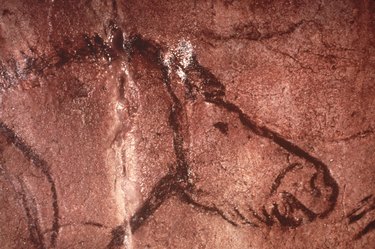
Lascaux Cave in southwestern France is full of wall paintings dating back to the Magdalenian period of the Upper Paleolithic Age. The polychrome, or multi-colored, pictures were executed more than 17,000 years ago and are among the best preserved artwork of its kind. The menagerie of animals depicted include horses, stags, cattle, mammoths, lions and bison. The paintings are notable for their large scale, naturalistic realism and correlation to fossilized remains found in the area. In addition, the artwork is indicative of the earliest ever created by modern humans.
Engraving Tools
Video of the Day
The more than 350 lithic, or stone tools, found on the floor of Lascaux cave had marks and scratches indicating their use for scraping and engraving. Engraved lines were an integral part of the painting process. Many of the animals feature incised outlines and anatomical details. Pigment found on some of the pointed and chisel-like tools shows they were used to etch lines into the partially completed or finished paintings. Crumbly sections of the cave walls commonly exhibit a drawing technique utilizing incision.
Video of the Day
Pigments
The Paleolithic palettes of the Lascaux painters consisted of black and a range of warm browns, reds, ochres and yellows. The locally dug, mineral-based pigments allowed a limited palette of earth tones. The artists ground up oxidized metallic element manganese to make black paint. Iron oxide, or rust, made the red colors. Hematite, a type of ferrous oxide, provided reddish-brown colors. Chemical analysis revealed the yellows to be Goethite, an oxidized, iron-bearing mineral. Clay ochres mixed with cave water yielded reddish, brown and yellow hues.
Painting Tools
The Lascaux artists employed crude crayons to paint on the smoother cave wall surfaces. Mined mineral pigments mixed with animal fats and plant juices produced rudimentary painting sticks. Sometimes the crayons contained additives such as ground feldspar or biotite mica as extenders. Paint applied with swabs and pads, probably made from moss and animal fur, created mottled effects. Watery pigments blown directly from the mouth or through tubes fashioned from hollow bones or reeds created a spray-painting technique for subtle shading effects.
Miscellaneous Tools
The Lascaux cave painters used a variety of tools to grind their paints, including round grindstones and the wedge-shaped shoulder bones of animals. Paintings located high up where the cave walls meet the ceiling required scaffolding. Holes found drilled in the cave walls likely supported wooden beams and ladders. The Lascaux paintings are far inside the cave, far from natural light sources. Over 100 lamps littered the cave floor. Most were limestone plates with a central depression for combustible animal fats.